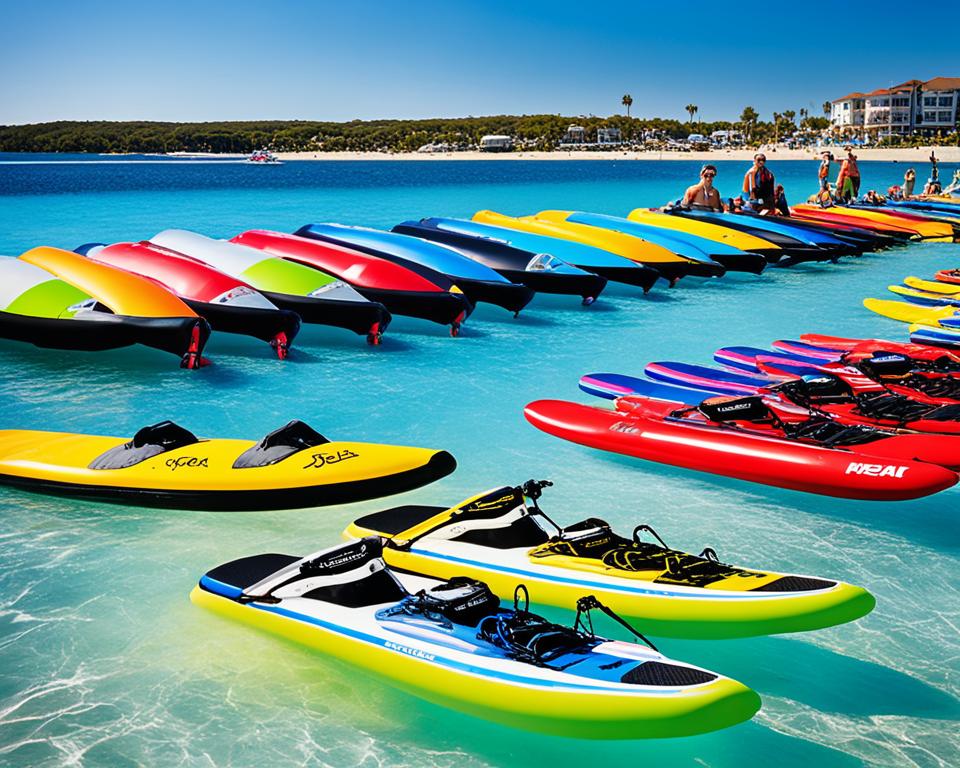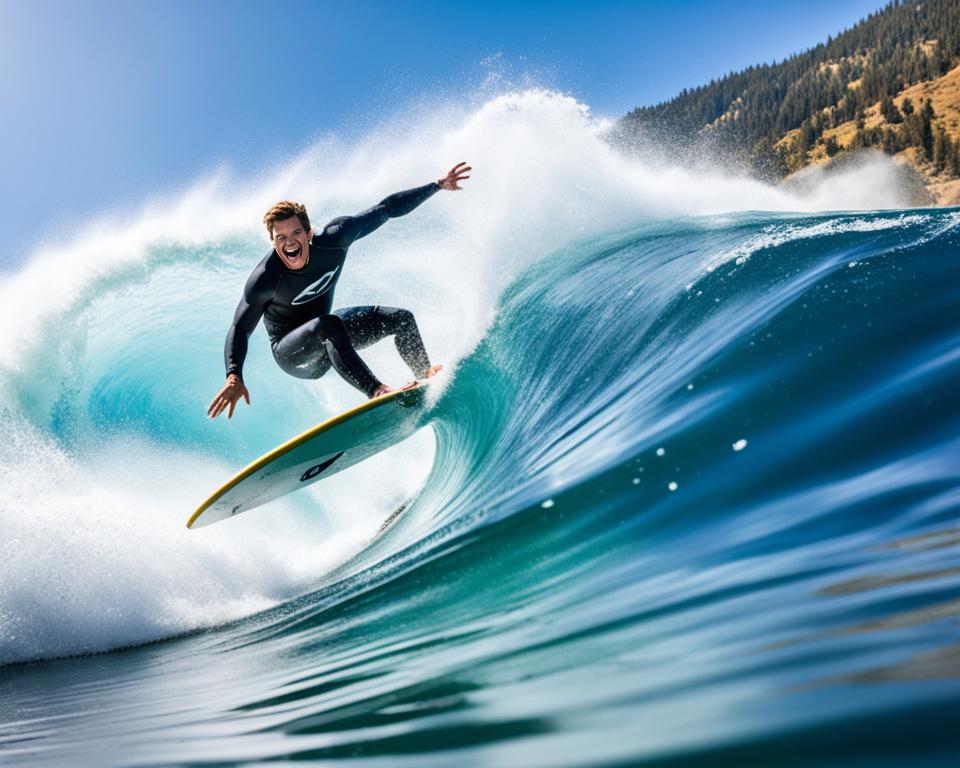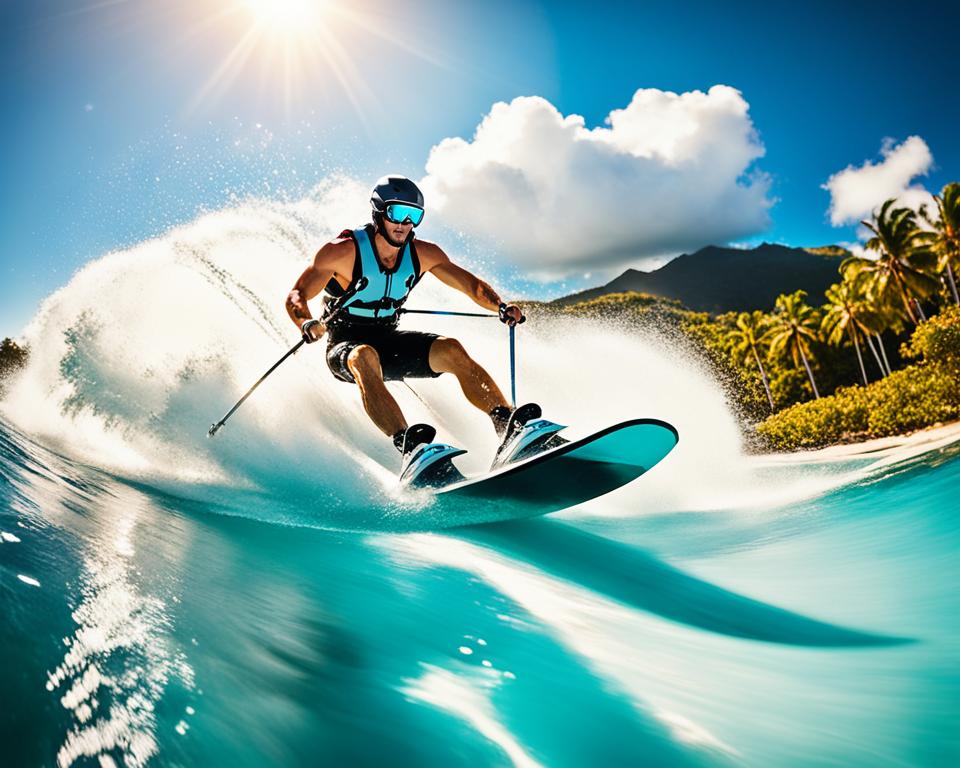Join us on an exciting journey into the world of water skis and the latest in aquatic gear. We’ll cover the thrilling history of water skiing and its many benefits. This guide aims to give you the knowledge to take your water adventures to the next level.
Learn about the wide variety of water skis, wakeboards, and tow boats that make these activities possible. Discover the key gear and techniques you need to become a pro in water sports. This article is perfect for both seasoned water skiers and beginners looking to dive into this exciting world.
Read interesting things at : kamilyle
Key Takeaways
- Discover the rich history and evolution of water sports, from their humble beginnings to the latest advancements.
- Explore the diverse range of water skis, wakeboards, and tow boats that power these exhilarating activities.
- Learn about the essential gear and techniques required to master water sports, including safety considerations.
- Uncover the benefits of water skiing, such as improved fitness, coordination, and stress relief.
- Dive into the world of specialized water sports equipment, including knee boards and hydrofoils.
Introduction to Water Skiing
Water skiing is a thrilling sport with a long history. It started in the early 1900s with people looking for new ways to have fun on the water. This led to the creation of many water sports we enjoy today.
History and Evolution of Water Sports
In the 1920s, a Minnesota teenager named Ralph Samuelson tried using wooden planks and a clothesline to ski on water. He was the first to do it successfully. This idea led to the creation of special water skis.
Since then, water skiing has changed a lot. Skis are now lighter, faster, and better designed. This has made the sport more exciting and let skiers do amazing things on the water.
Benefits of Water Skiing
- Improved cardiovascular fitness and muscle strength
- Enhanced coordination and balance
- Stress relief and relaxation
- Opportunities for social interaction and family bonding
- Adrenaline-fueled excitement and a sense of freedom
Water skiing is exciting whether you’re new to it or have been doing it for years. It’s about feeling the wind, enjoying the ride, and having fun. Get ready to start an adventure full of thrills on the water.
Essential Water Skiing Gear
Water skiing requires the right gear for a fun and safe time. From the skis to the accessories, each piece is crucial. Let’s look at the different types of water skis that can improve your experience.
Types of Water Skis
There are many ski designs for water skiing, each for different skills and tastes. Here are the main types:
- Slalom Skis – These skis are great for precise turns and are used by those who are good to very good at skiing. They are narrower and shorter, perfect for making sharp turns and going through buoys.
- Trick Skis – These skis are for doing tricks and aerial moves. They are wider and more stable, helping skiers do jumps and spins.
- All-Purpose Skis – These skis are versatile and good for many types of skiing, from cruising to some tricks. They are a good choice for those starting out or improving their skills.
When picking water skis, think about your skill level, your body type, and what you want to do on the water. The right skis can greatly improve your skiing.
| Ski Type | Key Features | Suitable for |
|---|---|---|
| Slalom Skis | Narrow, short, agile | Intermediate to advanced skiers |
| Trick Skis | Wide, stable, for stunts | Experienced trick skiers |
| All-Purpose Skis | Balanced agility and stability | Beginners and intermediate skiers |
Choosing the right water skiing gear is key to a great experience. Knowing about the different skis helps you pick the best one for your level and what you want to do on the water.
Choosing the Right Water Skis
Finding the perfect pair of water skis is key to your water adventures. It doesn’t matter if you’re a pro or new to the sport. Knowing what to look for in choosing water skis is crucial for a great time on the water.
The size of the skis matters a lot. Your height, weight, and how skilled you are will help pick the right size and shape. Longer skis are stable and good for beginners. Shorter skis are agile and better for those who know the sport well.
The material of the skis affects how they perform. Fiberglass and carbon fiber skis are light, strong, and durable. Wooden skis give a classic feel. The shape of the skis, from tip to tail, also changes how they handle and stay stable.
Getting the bindings right is important for a good fit. Make sure they adjust to fit your foot size and connect securely to the skis. This makes controlling the skis easier and improves your experience.
| Ski Size | Skill Level | Recommended Length |
|---|---|---|
| Beginner | Novice | 68-72 inches |
| Intermediate | Experienced | 72-78 inches |
| Advanced | Expert | 78-84 inches |
Think about these factors to make sure your water ski selection fits your level, likes, and the water skiing experience you want. Do your homework, try out different skis, and choose wisely for a fun and memorable time on the water.
Wakeboarding: Riding the Wake
Wakeboarding is a thrilling water sport that lets adventurers feel the power of the wake. It’s a fun way to move through the water with skill and grace.
Understanding Wakeboards
The wakeboard is key to wakeboarding. It’s made to help riders connect with the water. It combines surfboards, water skis, and snowboards for a unique way to do tricks in the water.
Wakeboarding Techniques
To be good at wakeboarding, you need balance, coordination, and technique. Riders do cool moves like turns, jumps, and spins. Learning how to control the board and move your weight can make your tricks better and more exciting.
| Wakeboarding Technique | Description |
|---|---|
| Edge Control | Maintaining precise control over the board’s edges to initiate turns, carves, and jumps. |
| Jumping the Wake | Launching off the boat’s wake to perform aerial tricks and stunts. |
| Inverts and Spins | Executing advanced maneuvers that involve rotating the body and board in the air. |
Wakeboarding is exciting for both experts and beginners. It offers endless fun and ways to grow as a rider.
Tow Boats: The Powerhouse Behind Aquatic Adventures
Tow boats are key to exciting water sports like water skiing and wakeboarding. They offer speed, stability, and control. These boats are made for a thrilling ride and keep everyone safe and happy.
These boats have strong engines and precise steering. They can keep a steady speed and path, even with many people on board. Their power helps lift skiers and boarders out of the water, letting them do cool moves and jump high.
The design of tow boats balances performance and safety. They have special systems, towers, and hulls for different water sports. This makes them versatile and safe, giving a smooth ride with no sudden speed changes.
Tow boats also make water sports look good. They have sleek designs and bright colors. This makes the experience more exciting for everyone, both those doing the sports and those watching.
If you love water skiing, wakeboarding, or just enjoy the rush of the water, tow boats are what make it happen. Their power and performance are what make these water sports so thrilling.
Water Sports Equipment: Enhancing Your Experience
Water sports equipment goes beyond traditional water skis. It includes specialized gear like knee boards and hydrofoils. These items can change how you experience the water.
Knee Boards: Versatile and Thrilling
Knee boards are loved by those who enjoy water sports. They offer a thrilling ride. Unlike water skis, knee boards are stable and easy to use, great for beginners and pros.
Knee boards let riders feel closer to the water. This makes the experience more connected to the water.
Hydrofoils: Elevating the Water Sports Experience
Hydrofoils are a new innovation in water sports equipment. They have a wing-like structure that lifts the boat or rider out of the water. This creates a smooth glide.
Hydrofoils add excitement and make riding faster and more agile. They change the way you move on the water.
For both experts and beginners, knee boards and hydrofoils offer exciting ways to enjoy the water. Try these water sports equipment to experience more thrill on the water.

“Knee boards and hydrofoils provide a unique and thrilling way to experience the water, unlocking a new level of excitement and freedom for water sports enthusiasts.”
Barefoot Skiing: The Ultimate Challenge
Barefoot skiing is the top thrill for those who love water sports. It’s when skiers go without traditional skis, using only their bare feet. They need skill, balance, and courage to move over the water.
This sport is different from regular water skiing. It requires special training, gear, and a lot of determination. Skiers must control their body well. They need to balance perfectly to stay on the water.
- Specialized Foot Gear: Barefoot skiers often wear protective foot coverings, such as neoprene booties, to provide traction and protection against the impact of the water.
- Optimized Tow Boats: The tow boats used in barefoot skiing are typically equipped with powerful engines and specialized tow systems to generate the necessary speed and pull for this extreme sport.
- Technique and Skill: Barefoot skiing demands a high level of lower body strength, core stability, and the ability to read the water’s surface and adjust accordingly.
For those who master barefoot skiing, the feeling is unmatched. It’s the thrill of moving over the water with no skis. This proves a person’s skill in extreme water sports.
“The feeling of gliding across the water with nothing but your bare feet is indescribable. It’s a level of connection with the elements that few other sports can match.”
Barefoot skiing is the top challenge in water sports. It draws in athletes looking for the most exciting and tough water adventures.
Aquaplaning: Gliding Across the Water
Aquaplaning lets you glide over the water’s surface with ease. It’s a thrilling way to experience the water. You need speed, skill, and the right gear to glide smoothly.
Mastering the Art of Aquaplaning
Also known as water gliding, aquaplaning means riding a special board on the water. It’s all about moving in a way that keeps you gliding smoothly. You need to know how the board, water, and your moves work together.
- Achieving the Optimal Speed: To aquaplane, you need to go at a certain speed, between 20-30 mph. This speed helps you use the water’s surface tension to lift you up.
- Balancing the Board: How you sit and spread your weight is key to staying stable and in control. This lets you turn and move smoothly.
- Mastering the Technique: It takes skill and a feel for the board to adjust to the water and keep gliding smoothly.
Aquaplaning is thrilling because you feel like you’re defying gravity. You glide across the water with ease. With the right gear and practice, you can enjoy the amazing feeling of aquaplaning and have fun on the water.
| Equipment | Technique | Safety |
|---|---|---|
| Specialized aquaplaning board | Maintaining optimal speed | Proper life jacket and protective gear |
| Tow rope and boat | Balancing weight distribution | Awareness of water conditions |
| Protective gear (life jacket, helmet) | Smooth, fluid movements | Proper rescue and emergency procedures |
Wake Surfing: Riding the Endless Wave
Imagine gliding on the water, riding the powerful wake of a special tow boat. This thrilling experience is what wake surfing offers. It combines the excitement of surfing with the ease of a controlled water setting. Wake surfing has become popular thanks to new tech in water sports.
Wake surfing uses special gear to let riders catch the boat’s wake. Wakeboards are wide and buoyant, making them great for smooth turns and tricks. When riders get more skilled, they can switch to wake surfboards. These boards feel like ocean surfboards but are made for the boat’s wake.
To be good at surfing on water, you need technique, balance, and to know the boat’s wake. Riders find the best spot in the wake to make smooth lines and do cool tricks. The joy of riding the wave comes from its variety, letting riders try different skills and styles.
“Wake surfing is a unique and exhilarating way to experience the power of the water. It’s a true blend of surf-inspired style and boat-powered excitement.”
Wake surfing is getting more popular, leading to new gear and techniques. From simple turns to complex tricks, there’s always something new to learn. It’s a journey that keeps thrill-seekers and water lovers coming back for more.

Safety Considerations for Water Sports
Water sports are exciting but safety comes first. Having the right gear and following safety rules are key. Let’s look at what you need for a safe and fun time in the water.
Proper Gear and Equipment
Choosing the right gear is vital for your safety and comfort. Always wear a life jacket or personal flotation device (PFD) to stay safe. You might also need helmets, wetsuits, protective pads, and special shoes for different sports.
Water Safety Guidelines
Learn the local water safety rules before you start. These rules include:
- Checking the weather and water before you go
- Not using alcohol or drugs while in the water
- Staying away from areas where swimming or boating is not allowed
- Keeping a safe distance from others in the water
- Watching out for dangers like hidden objects or strong currents
By following these guidelines and wearing the right gear, you can enjoy water sports safely.
Always put safety first in water sports. By being careful and following the best practices, you can have a great time in the water while staying safe.
Top Destinations for Water Skiing Adventures
Start an exciting journey around the world to find the best water skiing destinations and best places for water sports. You’ll see beautiful lakeside spots and sunny coastal areas. These places are perfect for amazing water adventures.
Jump into the clear waters of Lake Tahoe. The Sierra Nevada mountains create a beautiful setting for water skiing. Then, visit Lake Minnetonka in Minnesota. It’s a favorite spot for water sports with great facilities.
Head to the Florida Panhandle for its green waters and fun water sports. Or, go to Lake Havasu, Arizona, for a unique experience with the London Bridge as your view.
| Destination | Key Features | Popular Activities |
|---|---|---|
| Lake Tahoe, California | Majestic mountain scenery, clear waters | Water skiing, wakeboarding, jet skiing |
| Lake Minnetonka, Minnesota | Diverse water sports facilities, scenic landscapes | Water skiing, wake surfing, kayaking |
| Florida Panhandle | Emerald-green waters, vibrant coastal culture | Water skiing, wakeboarding, parasailing |
| Lake Havasu, Arizona | Iconic London Bridge, desert oasis setting | Water skiing, wakeboarding, jet skiing |
Whether you’re an expert or new to water sports, these top water skiing destinations offer an amazing time. You’ll find thrills, beauty, and chances to improve your water skills.
Maintaining and Caring for Your Water Sports Gear
Looking after your water sports gear is key to its lasting performance. Whether you’re into water skiing, wakeboarding, or aquaplaning, the right care can enhance your outdoor fun. It’s all about keeping your gear in top shape for your next adventure.
Storing and Transporting Equipment
Keeping your gear clean and organized is vital when storing it. Always clean your equipment after use to remove dirt, sand, and salt. This keeps it from corroding and extends its life. Keep your skis, boards, and other items in a cool, dry spot, out of the sun.
Use protective cases or bags to keep your gear safe from the elements. This helps maintain its quality.
Getting your gear to your destination safely is also important. Make sure it’s securely fastened to your car to avoid damage. Use strong roof racks or trailers made for water sports gear. Always follow the maker’s advice for safe transport.
- Clean equipment thoroughly after each use
- Store gear in a cool, dry place, away from direct sunlight
- Use protective cases or bags to shield equipment
- Secure equipment properly during transport
By following these easy steps, your water sports gear will stay in great shape. It’ll be ready for your next exciting water adventure.
“Taking care of your water sports equipment is just as important as mastering the techniques. With proper maintenance, your gear will serve you well for years to come.”
Tips and Tricks for Beginners
Starting your water sports journey can be thrilling. It’s key to begin right. Learning from experts can boost your skills and make it safe and fun.
Learning from Water Sports Professionals
Getting tips from seasoned instructors and athletes is a great way to improve. They share key techniques, how to pick the right gear, and safety tips. This helps you skip common mistakes and learn faster.
- Sign up for classes made for beginners to get hands-on lessons and feedback.
- Join local water sports clubs or communities for a network of mentors.
- Follow social media and blogs of famous water sports stars for new tips and trends.
Experts teach you the basics and help you gain confidence. This lets you try harder moves and discover new aspects of these exciting sports.
“The key to becoming a proficient water sports enthusiast is to start with the right guidance and never stop learning.”
Water sports are about the journey, not just reaching the end. Enjoy learning, listen to advice, and have fun as you dive into water-based adventures.
Future Trends in Water Sports
The water sports industry is always changing, bringing new and exciting trends. These changes include new technologies and better equipment. They make water sports more thrilling for both experts and beginners.
Eco-friendly water sports are becoming more popular. People want to help the environment while enjoying their sports. So, we’re seeing more electric boats and boards, and gear made from recycled materials.
Augmented reality (AR) and virtual reality (VR) are also changing water sports. Imagine seeing your performance in real-time or practicing new moves in a virtual world. These technologies could change how we train, coach, and watch water sports.
| Emerging Trend | Potential Impact |
|---|---|
| Eco-friendly Water Sports | Reduced environmental impact, increased sustainability |
| AR/VR Integration | Enhanced training, coaching, and spectator experiences |
| Hydrofoil Technology | Increased speed, efficiency, and accessibility for water sports |
Hydrofoil technology is also making waves in water sports. It lifts the rider or board out of the water, making sports faster and more accessible. This could open up water sports to more people.
These trends and innovations will keep making water sports exciting for everyone. They’ll let athletes and newcomers experience the thrill of the water like never before. The water sports industry is set to offer even more exciting experiences for the future.
Conclusion
This guide has taken you on an exciting journey through water sports. We’ve covered the history, evolution, and the latest gear and techniques. It’s perfect for both seasoned enthusiasts and newcomers.
We looked at water skiing, wakeboarding, and more. We also talked about the thrill of barefoot skiing and wake surfing. You now know the basics and how to stay safe while having fun.
Keep exploring and remember the tips from this guide. They will help you enjoy water sports even more. With this knowledge, you’re ready to dive into new adventures with confidence.


